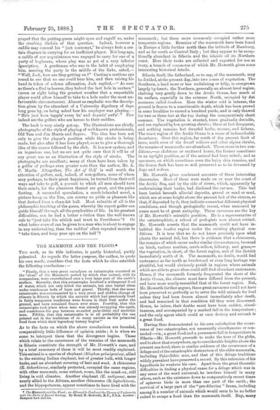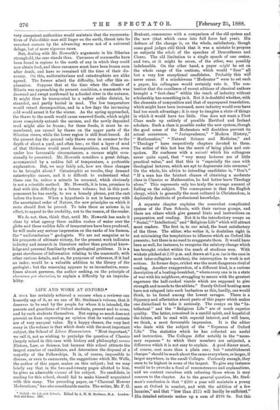THE MAMMOTH AND THE FLOOD.* Tam work, as its title
indicates, is partly historical, partly polemical. As regards the latter purpose, the author, to quote his own words, considers that the facts which he cites establish the following conclusions :—
"Firstly, that a very great cataclysm or catastrophe occurred at the close' of the Mammoth period by which that animal, with its companions, were overwhelmed over a very large part of the earth's surface. Secondly, that this catastrophe involved a widespread flood of water, which not only killed the animals, but also buried them under continuous beds of loam and gravel. Thirdly, that the same catastrophe was accompanied by a very great and sadden change of climate in Siberia by which the animals which had previously lived in fairly temperate conditions were frozen in their flesh under the ground, and have remained frozen ever since. Fourthly, that this catastrophe took place when man was already occupying the earth, and constitutes the gap between so-called pake)lithic and neolithic man. Fifthly, that this catastrophe is in all probability the one pointed out in the traditions of so many nations as the primeval flood from which their legendary history begins."
As to the facts on which the above conclusions are founded, comparatively little difference of opinion exists ; it is when we come to interpret them that the divergence begins. Those which relate to the occarrence of the remains of the mammoth in Siberia constitute the strength of Mr. Howorth's case, and by a brief summary of them it will be most readily explained. This animal is a species of elephant (Elephas primigeniue), allied to the existing Indian elephant, but of greater bulk, with longer tusks, and an abundant covering of hair and wool. A rhinoceros tieleorhinus), similarly protected, occupied the same regions, with other mammals, some extinct, some, like the musk-ox, still living in cold climates. Another elephant (E. antiques,), more nearly allied to the African, another rhinoceros (B. leptorhinus), and the hippopotamus, appear sometimes to have lived with the
• The Matnntoth and the Flood ; an Attempt to Confront the Theory of Uniformity with the Facts of Recent Geology. By Henry H. Howorth, M.P., 7.8.5.. London : Sampson Low and Co.
mammoth; but these more commonly occupied rather more temperate regions. Remains of the mammoth have been found in Europe a little further north than the latitude of Hamburg, and as far south as Central Italy ; but they appear to be excep- tionally abundant in Siberia and the islands off its Northern coast. Here their tusks are collected and exported for use as ivory, a branch of commerce of which Mr. Howorth gives some interesting historical details.
Siberia itself, the fatherland, so to say, of the mammoth, may be divided, at the present day, into two zones of vegetation. The Southern, a land more or less undulating or hilly, is overgrown largely by forest; the Northern, generally an almost level region, shelving very gently down to the Arctic Ocean, has much of its surface, especially in the extreme North, occupied by flat morasses called tundras. Here the winter cold is intense, the ground is frozen to a considerable depth, which has been proved in some localities to exceed a hundred yards, and is only thawed for two or three feet at the top during the comparatively short summer. The vegetation is stunted, trees gradually dwindle, and are replaced by low-growing shrubs ; these at last disappear, and nothing remains but dwarfed herbs, mosses, and lichens. The coast region of the Arctic Ocean is a scene of indescribable dreariness. Over this region, far north of the present limit of trees, north even of the dwarf willows and other alpine shrubs, the remains of mammoths are abundant. These occur in two con- ditions,—as skeletons or scattered bones, the former sometimes in an upright position, as if the animal had been mired ; and as carcasses, on which sometimes even the hairy skin remains, and the frozen flesh has been so well preserved as to be devoured by dogs and wolves.
Mr. Howorth gives condensed accounts of these interesting discoveries. Most of them were made on or near the coast of the Arctic Sea, and by the side of rivers, which, apparently by undermining their banks, had disclosed the carcass. This had been buried beneath alluvial deposits, gravel or sand or mud, which are at some height above the present bed of the stream, so that, if deposited by it, they indicate somewhat different physical conditions, and though geologically recent, when measured by years must be of great antiquity. These carcasses are the key of Mr. Howorth's scientific position. He is a representative of the catastrophists, a school of geologists now almost extinct. Mr. Howorth asserts that the mammoth could not have in- habited the tundra region under the existing physical con- ditions. It is true that we do not know precisely upon what plants the animal fed, but there is evidence that a rhinoceros, the remains of which occur under similar circumstances, browsed on birch, various conifers, scrub-willow, bilberry, and grass,— the vegetation, in short, of the forest region, and of the district immediately north of it. The mammoth, no doubt, would find sustenance as far north as brushwood or even long herbage was plentiful, but would obviously perish in regions where animals which are able to graze close could still find abundant sustenance. Hence, if the mammoth formerly frequented the shore of the Arctic Ocean, the climate must have differed from the present, and have more nearly resembled that of the forest region. But, Mr. Howorth further argues, these great carcasses could not have been preserved so perfectly as to serve the wild animals for food unless they had been frozen almost immediately after death, and had remained in that condition till they were discovered. Hence, he infers, their deaths must have been sudden, simul- taneous, and accompanied by a marked fall in the temperature ; and the only agent which could at once destroy and entomb is a great flood.
Having thus demonstrated to his own satisfaction the occur- rence of two catastrophes, not necessarily simultaneous or con- nected—viz., a great flood and a permanent fall in temperature in Siberia—Mr. Howorth proceeds to make the tour of the globe, and to show that everywhere, up to considerable heights above the present sea-level, there is similar evidence of the occurrence of a deluge and of the catastrophic destruction of the older mammalia, including Pala3olithic man, and that of this deluge traditions widely prevalent have preserved a record. By this extension of his hypothesis he weakens his case. Apart from the great theoretic difficulties in finding a physical cause for a deluge which was in any sense of the word universal, he involves himself in many others, such as the existence down to comparatively recent times of apterous birds in more than one part of the earth ; the survival of a large part of the " pre.diluvian " fauna, including among it a number of animals which would seem to be no better suited to escape a flood than the mammoth itself. Nay, many
very competent authorities would maintain that the representa- tives of PalmoEthic man still linger on the earth, thrust into its remotest corners by the advancing waves not of a universal deluge, but of more vigorous races. But, dealing with Mr. Howorth's arguments in his Siberian stronghold, the case stands thus. Carcasses of mammoths have been found in regions to the north of any in which they could now obtain food, and these carcasses must have been frozen soon after death, and have so remained till the time of their dis- covery. On this, uniformitariaus and catastrophists are alike agreed. The former admit the difficulty, but offer this ex- planation. Suppose that at the time when the climate of Siberia was approaching its present condition, a mammoth was drowned and swept northward by a flooded river in the autumn. It might thus be transported to a rather colder district, be stranded, and partly buried in mud. The low temperature would retard decomposition, and in a few days the increasing cold would arrest it for the winter. As the spring approached, the thaws to the south would cause renewed floods, which might more completely entomb the carcass, and the newly deposited mud might also be frozen ; for these floods, it must be re- membered, are caused by thaws on the upper parts of the Siberian rivers, while the lower region is still frost-bound. At the present day the ground only thaws even in summer to the depth of about a yard, and often less ; so that a layer of mud of that thickness would avert decomposition, and thus, even under less favourable circumstances, a carcass might occa- sionally be preserved. Mr. Howorth considers a great deluge, accompanied by a sudden fall of temperature, a preferable explanation. But, we may fairly ask, how are these changes to be brought about ? Catastrophic as results, they demand catastrophic causes, and it is difficult to understand what these can be, unless a miracle be assumed, which obviously is not a scientific method. Mr. Howorth, it is true, promises to deal with this difficulty in a future volume ; but in this post- ponement he has surely, to use a homely phrase, put the cart before the horse. When a hypothesis is not in harmony with the ascertained order of Nature, the new principles on which it rests should first be proved. To take these as axioms is, in effect, to appeal to the credulity, not to the reason, of the reader.
We do not, then, think that, until Mr. Howorth has made it clear by what agency these sudden rushes of water over the globe and these sudden falls of temperature have been produced, he will make any serious impression on the ranks of his foemen, the " uniformitarian " geologists. We are not sanguine as to his prospects of ultimate victory, for the present work indicates industry and research in literature rather than practical know- ledge and personal familiarity with geological problems. It is a great storehouse of information relating to the mammoth, with other carious details, and so, for purposes of reference, if it had an index, would be a valuable addition to the library of the geologist ; but the reasoning appears to us inconclusive, some- times almost perverse, the author seeking, on the principle of obscurum per obscurizcs, to explain a difficulty by an improba- bility.







































 Previous page
Previous page